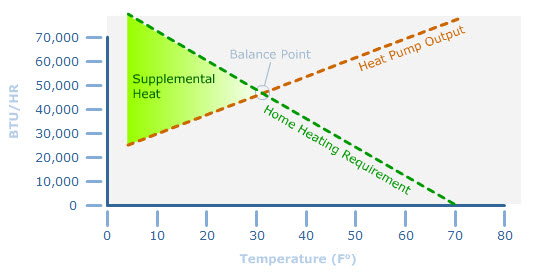8.6: Cooling and Heating (II)
- Page ID
- 50307
Air-Source Heat Pump or Air-to-Air Heat Pump
An air-source or air-to-air heat pump can provide both heating and cooling.
- In the winter, a heat pump extracts heat from outside air and delivers it indoors.
- On hot summer days, it works in reverse, extracting heat from room air and pumping it outdoors to cool the house.
Nearly all air-source and air-to-air heat pumps are powered by electricity. They have an outdoor compressor/ condenser unit that is connected with refrigerant-filled tubing to an indoor air handler. As the refrigerant moves through the tubing of the system, it completes a basic refrigeration cycle, warming or cooling the coils inside the air handler. The blower pulls in room air, circulates it across the coils, and pushes the air through ductwork back into rooms.
When extra heat is needed on particularly cold days, supplemental electric-resistance elements kick on inside the air handler to add warmth to the air that is passing through.
In the winter, a heat pump extracts heat from outside air and delivers it indoors. In the summer, the heat pump extracts heat from room air and pumps it outdoors to cool the house.
The videos below explains the heating and cooling cycles of a heat pump.
The Balance Point
As we have learned, air-source and air-to-air heat pumps work by extracting heat from the outside air. These heat pumps require a backup system to supplement their heating ability when the outdoor temperature gets below a certain temperature.
As the outdoor temperature drops, the heating requirement of the house increases and the output of the heat pump decreases. At some point, the temperature of the home’s heating requirement and the heat pump output match. This temperature is called the balance point and usually falls between 30-45 degrees Fahrenheit. For any temperatures below the balance point, supplemental heat will be required.
To locate the balance point, the heating requirement (BTUs/h) of the house and the heat pump output (BTUs/h) are plotted against the changes in outside temperature. The place where the home heating requirement and heat pump output lines cross is the balance point.
Figure 8.6.2 shows a graph of the balance point.

Figure 8.6.2. Balance point
Efficiency of a Heat Pump
Efficiency of a heat pump is measured using a term coefficient of performance (COP), and it is the ratio of the useful heat that is pumped to a higher temperature, to a unit amount of work that is put in. We will look at COP in terms of air-source heat pumps.
A general expression for the efficiency of a heat engine can be written as
\[ COP = \dfrac{(Heat \, Energy)_{hot}}{Work} \]
Using the same logic that was used for heat engines, equation 8.6.1 becomes
\[ COP = \dfrac{Q_{hot}}{Q_{hot} - Q_{cold}} \]
where Qhot is the heat input at high temperature and Qcold is the heat rejected at low temperature. Thus, equation 8.6.2 can be rewritten as
\[ COP = \dfrac{T_{hot}}{T_{hot} - T_{cold}} \]
Note
Thot and Tcold must be expressed in units of Kelvin.
Example Problems
Example 1
Calculate the ideal COP for an air-to-air heat pump used to maintain the temperature of a house at 70°F when the outside temperature is 30°F.
- Answer
-
Add texts here. Do not delete this text first.
First, convert the Fahrenheit temperatures to Celsius temperatures using
\[ T_{hot} = (70 - 32) * \dfrac{5}{9} = 21°C \nonumber\]
\[ T_{cold} = (30 - 32) * \dfrac{5}{9} = -1°C \nonumber\]
Next, convert the Celsius temperatures to Kelvin temperatures by adding 273:
\[ T_{hot} = 21°C + 273 = 294 K \nonumber\]
\[ T_{cold} = -1°C + 273 = 272 K \nonumber\]
Finally, use equation 8.6.3 to solve for the COP:
\[ COP = \dfrac{T_{hot}}{T_{hot} - T_{cold}} \nonumber\]
\[ COP = \dfrac{294 \, K}{294 \, K - 272 \, K} = 13.3 \nonumber\]
Example 1 shows that for every watt of power we use (and pay for) to drive this ideal heat pump, 13.3 W is delivered to the interior of the house and 12.3 from the outside (we don’t pay for this). This seems to be a deal that one cannot refuse. However, the theoretical maximum is never achieved in the real world. In practice, a COP in the range of 2 to 6 is typical. Even with this range, it is an excellent choice, because for every watt of power that we use, we transfer 1 to 5 additional watts from outside.
Example 2
Compare the ideal coefficients of performance of the same heat pump installed in State College, PA and Ann Arbor, MI when the inside temperature of a house is maintained at 70°F at both locations and the outside temperatures on a given day were 40°F and 15°F at State College and Ann Arbor, respectively.
- Answer
-
Add texts here. Do not delete this text first.
State College, PA Ann Arbor, MI Thot = 70°F = 294 K Thot = 70°F = 294 K Tcold = 40°F = 277 K Tcold = 15°F = 264 K \[ COP = \dfrac{294 \, K}{294 \, K - 272 \, K} = 17.3 \nonumber\] \[ COP = \dfrac{294 \, K}{294 \, K - 264 \, K} = 9.8 \nonumber\]
Note
During a heating season, the heat pump's efficiency increases on mild days and decreases on cold days.

